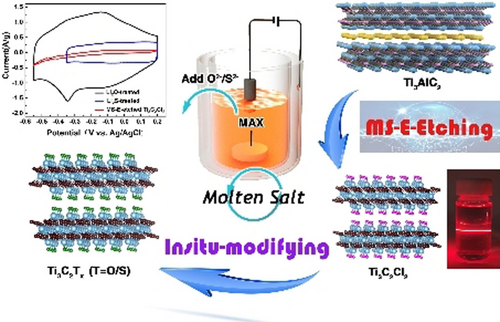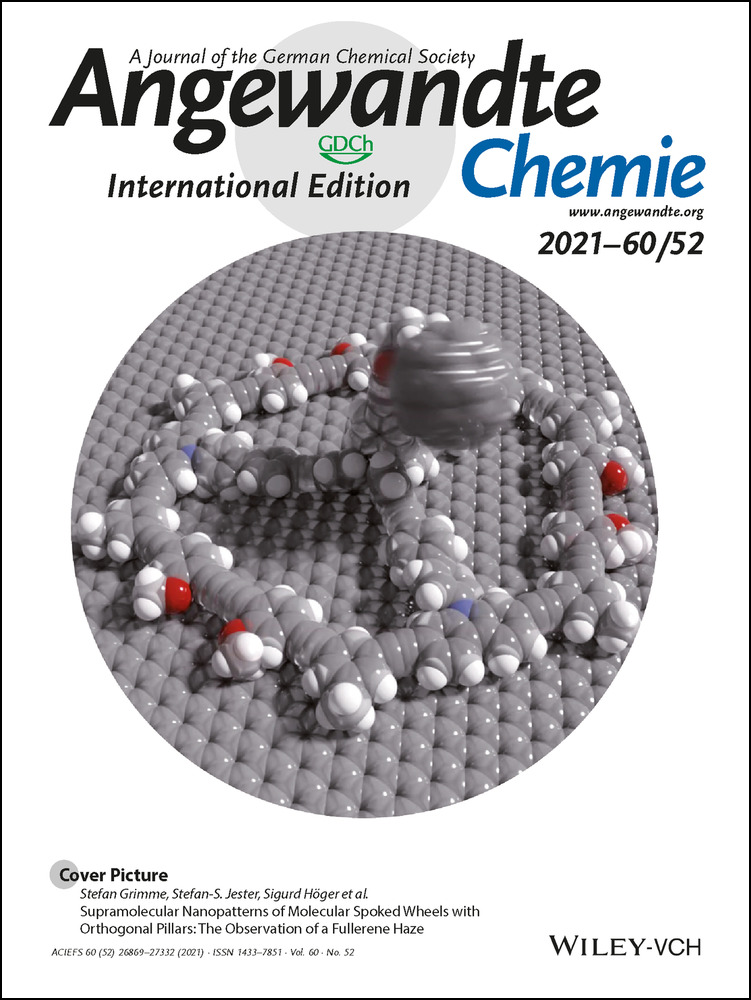One-Pot Green Process to Synthesize MXene with Controllable Surface Terminations using Molten Salts
Corresponding Author
Dr. Miao Shen
Shanghai Institute of Applied Physics, Chinese Academy of Sciences, Shanghai, 201800 China
Search for more papers by this authorWeiyan Jiang
Shanghai Institute of Applied Physics, Chinese Academy of Sciences, Shanghai, 201800 China
Search for more papers by this authorDr. Kun Liang
Department of Physics and Engineering Physics, Tulane University, New Orleans, LA, 70118 USA
Search for more papers by this authorDr. Sufang Zhao
Shanghai Institute of Applied Physics, Chinese Academy of Sciences, Shanghai, 201800 China
Search for more papers by this authorCorresponding Author
Rui Tang
Shanghai Institute of Applied Physics, Chinese Academy of Sciences, Shanghai, 201800 China
Search for more papers by this authorDr. Linjuan Zhang
Shanghai Institute of Applied Physics, Chinese Academy of Sciences, Shanghai, 201800 China
Search for more papers by this authorCorresponding Author
Prof. Jian-Qiang Wang
Shanghai Institute of Applied Physics, Chinese Academy of Sciences, Shanghai, 201800 China
Search for more papers by this authorCorresponding Author
Dr. Miao Shen
Shanghai Institute of Applied Physics, Chinese Academy of Sciences, Shanghai, 201800 China
Search for more papers by this authorWeiyan Jiang
Shanghai Institute of Applied Physics, Chinese Academy of Sciences, Shanghai, 201800 China
Search for more papers by this authorDr. Kun Liang
Department of Physics and Engineering Physics, Tulane University, New Orleans, LA, 70118 USA
Search for more papers by this authorDr. Sufang Zhao
Shanghai Institute of Applied Physics, Chinese Academy of Sciences, Shanghai, 201800 China
Search for more papers by this authorCorresponding Author
Rui Tang
Shanghai Institute of Applied Physics, Chinese Academy of Sciences, Shanghai, 201800 China
Search for more papers by this authorDr. Linjuan Zhang
Shanghai Institute of Applied Physics, Chinese Academy of Sciences, Shanghai, 201800 China
Search for more papers by this authorCorresponding Author
Prof. Jian-Qiang Wang
Shanghai Institute of Applied Physics, Chinese Academy of Sciences, Shanghai, 201800 China
Search for more papers by this authorGraphical Abstract
This is the first study to use a molten-salt-assisted electrochemical etching (MS-E-etching) method to synthesize Ti3C2Cl2 without metallic impurities. The Tx surface terminations could be in situ modified from −Cl to −O and/or −S in this one-pot process. The obtained −O-terminated Ti3C2Tx electrode exhibited a significant increase in capacity.
Abstract
Surface terminations of two-dimensional MXene (Ti3C2Tx) considerably impact its physicochemical properties. Commonly used etching methods usually introduce -F surface terminations or metallic impurities in MXene. We present a new molten-salt-assisted electrochemical etching method to synthesize fluorine-free Ti3C2Cl2. Using electrons as reaction agents, cathode reduction and anode etching can be spatially isolated; thus, no metallics are present in the Ti3C2Cl2 product. The surface terminations can be in situ modified from −Cl to −O and/or −S, which considerably shortens the modification steps and enriches the variety of surface terminations. The obtained −O-terminated Ti3C2Tx are excellent electrode materials for supercapacitors, exhibiting capacitances of 225 F g−1 at 1.0 Ag−1, good rate performance (91.1 % at 10 Ag−1), and excellent capacitance retention (100 % after 10000 charge/discharge cycles at 10 Ag−1), which is superior to multi-layered Ti3C2Tx prepared by other etching methods.
Conflict of interest
The authors declare no conflict of interest.
Supporting Information
As a service to our authors and readers, this journal provides supporting information supplied by the authors. Such materials are peer reviewed and may be re-organized for online delivery, but are not copy-edited or typeset. Technical support issues arising from supporting information (other than missing files) should be addressed to the authors.
| Filename | Description |
|---|---|
| anie202110640-sup-0001-misc_information.pdf2.4 MB | Supporting Information |
Please note: The publisher is not responsible for the content or functionality of any supporting information supplied by the authors. Any queries (other than missing content) should be directed to the corresponding author for the article.
References
- 1B. Anasori, M. R. Lukatskaya, Y. Gogotsi, Nat. Rev. Mater. 2017, 2, 16098.
- 2V. Nicolosi, M. Chhowalla, M. G. Kanatzidis, M. S. Strano, J. N. Coleman, Science 2013, 340, 1420–1420.
- 3M. Naguib, M. Kurtoglu, V. Presser, J. Lu, J. Niu, M. Heon, L. Hultman, Y. Gogotsi, M. W. Barsoum, Adv. Mater. 2011, 23, 4248–4253.
- 4M. Naguib, V. N. Mochalin, M. W. Barsoum, Y. Gogotsi, Adv. Mater. 2014, 26, 992–1005.
- 5M. Ghidiu, M. R. Lukatskaya, M.-Q. Zhao, Y. Gogotsi, M. W. Barsoum, Nature 2014, 516, 78–81.
- 6F. Shahzad, M. Alhabeb, C. B. Hatter, B. Anasori, S. M. Hong, C. M. Koo, Y. Gogotsi, Science 2016, 353, 1137–1140.
- 7Y. Liu, H. Xiao, W. A. Goddard, J. Am. Chem. Soc. 2016, 138, 15853–15856.
- 8C. Si, J. Zhou, Z. Sun, ACS Appl. Mater. Interfaces 2015, 7, 17510–17515.
- 9M. Khazaei, M. Arai, T. Sasaki, C.-Y. Chung, N. S. Venkataramanan, M. Estili, Y. Sakka, Y. Kawazoe, Adv. Funct. Mater. 2013, 23, 2185–2192.
- 10L. Zhou, Y. Zhang, Z. Zhuo, A. J. Neukirch, S. Tretiak, J. Phys. Chem. Lett. 2018, 9, 6915–6920.
- 11S. Husmann, Ö. Budak, H. Shim, K. Liang, M. Aslan, A. Kruth, A. Quade, M. Naguib, V. Presser, Chem. Commun. 2020, 56, 11082–11085.
- 12J. Halim, M. R. Lukatskaya, K. M. Cook, J. Lu, C. R. Smith, L.-Å. Näslund, S. J. May, L. Hultman, Y. Gogotsi, P. Eklund, Chem. Mater. 2014, 26, 2374–2381.
- 13M. A. Hope, A. C. Forse, K. J. Griffith, M. R. Lukatskaya, M. Ghidiu, Y. Gogotsi, C. P. Grey, Phys. Chem. Chem. Phys. 2016, 18, 5099–5102.
- 14T. Li, L. Yao, Q. Liu, J. Gu, R. Luo, J. Li, X. Yan, W. Wang, P. Liu, B. Chen, W. Zhang, W. Abbas, R. Naz, D. Zhang, Angew. Chem. Int. Ed. 2018, 57, 6115–6119; Angew. Chem. 2018, 130, 6223–6227.
- 15M. Li, J. Lu, K. Luo, Y. Li, K. Chang, K. Chen, J. Zhou, J. Rosen, L. Hultman, P. Eklund, P. O. Å. Persson, S. Du, Z. Chai, Z. Huang, Q. Huang, J. Am. Chem. Soc. 2019, 141, 4730–4737.
- 16Y. Li, H. Shao, Z. Lin, J. Lu, L. Liu, B. Duployer, P. O. Å. Persson, P. Eklund, L. Hultman, M. Li, K. Chen, X.-H. Zha, S. Du, P. Rozier, Z. Chai, E. Raymundo-Piñero, P.-L. Taberna, P. Simon, Q. Huang, Nat. Mater. 2020, 19, 894–899.
- 17S. Kajiyama, L. Szabova, H. Iinuma, A. Sugahara, K. Gotoh, K. Sodeyama, Y. Tateyama, M. Okubo, A. Yamada, Adv. Energy Mater. 2017, 7, 1601873.
- 18V. Kamysbayev, A. S. Filatov, H. Hu, X. Rui, F. Lagunas, D. Wang, R. F. Klie, D. V. Talapin, Science 2020, 369, 979–983.
- 19R. B. Rakhi, B. Ahmed, M. N. Hedhili, D. H. Anjum, H. N. Alshareef, Chem. Mater. 2015, 27, 5314–5323.
- 20S. Lai, J. Jeon, S. K. Jang, J. Xu, Y. J. Choi, J.-H. Park, E. Hwang, S. Lee, Nanoscale 2015, 7, 19390–19396.
- 21K. Wang, Y. Zhou, W. Xu, D. Huang, Z. Wang, M. Hong, Ceram. Int. 2016, 42, 8419–8424.
- 22M. Han, X. Yin, H. Wu, Z. Hou, C. Song, X. Li, L. Zhang, L. Cheng, ACS Appl. Mater. Interfaces 2016, 8, 21011–21019.
- 23X.-T. Gao, Y. Xie, X.-D. Zhu, K.-N. Sun, X.-M. Xie, Y.-T. Liu, J.-Y. Yu, B. Ding, Small 2018, 14, 1802443.
- 24H. Pan, X. Huang, R. Zhang, D. Wang, Y. Chen, X. Duan, G. Wen, Chem. Eng. J. 2019, 358, 1253–1261.
- 25S. Sardar, A. Jana, Matter 2020, 3, 1397–1399.
- 26X. Xiao, H. Song, S. Lin, Y. Zhou, X. Zhan, Z. Hu, Q. Zhang, J. Sun, B. Yang, T. Li, L. Jiao, J. Zhou, J. Tang, Y. Gogotsi, Nat. Commun. 2016, 7, 11296.
- 27W. Weng, B. Jiang, Z. Wang, W. Xiao, Sci. Adv. 2020, 6, eaay9278.
- 28X. Liang, J. Xiao, W. Weng, W. Xiao, Angew. Chem. Int. Ed. 2021, 60, 2120–2124; Angew. Chem. 2021, 133, 2148–2152.
- 29R. S. Alwitt, H. Uchi, T. R. Beck, R. C. Alkire, J. Electrochem. Soc. 1984, 131, 13–17.
- 30W. Sun, S. A. Shah, Y. Chen, Z. Tan, H. Gao, T. Habib, M. Radovic, M. J. Green, J. Mater. Chem. A 2017, 5, 21663–21668.
- 31M. R. Lukatskaya, J. Halim, B. Dyatkin, M. Naguib, Y. S. Buranova, M. W. Barsoum, Y. Gogotsi, Angew. Chem. Int. Ed. 2014, 53, 4877–4880; Angew. Chem. 2014, 126, 4977–4980.
- 32M.-Q. Zhao, M. Sedran, Z. Ling, M. R. Lukatskaya, O. Mashtalir, M. Ghidiu, B. Dyatkin, D. J. Tallman, T. Djenizian, M. W. Barsoum, Y. Gogotsi, Angew. Chem. Int. Ed. 2015, 54, 4810–4814; Angew. Chem. 2015, 127, 4892–4896.
- 33M. R. Lukatskaya, O. Mashtalir, C. E. Ren, Y. Dall′Agnese, P. Rozier, P. L. Taberna, M. Naguib, P. Simon, M. W. Barsoum, Y. Gogotsi, Science 2013, 341, 1502–1505.
- 34O. Mashtalir, M. Naguib, V. N. Mochalin, Y. Dall′Agnese, M. Heon, M. W. Barsoum, Y. Gogotsi, Nat. Commun. 2013, 4, 1716.
- 35Z. Li, L. Wang, D. Sun, Y. Zhang, B. Liu, Q. Hu, A. Zhou, Mater. Sci. Eng. B 2015, 191, 33–40.
- 36J. Xu, T. White, P. Li, C. He, J. Yu, W. Yuan, Y.-F. Han, J. Am. Chem. Soc. 2010, 132, 10398–10406.
- 37J. Halim, K. M. Cook, M. Naguib, P. Eklund, Y. Gogotsi, J. Rosen, M. W. Barsoum, Appl. Surf. Sci. 2016, 362, 406–417.
- 38V. Schier, H. J. Michel, J. Halbritter, Fresenius J. Anal. Chem. 1993, 346, 227–232.
- 39E. Magni, G. A. Somorjai, Surf. Sci. 1996, 345, 1–16.
- 40C. Mousty-Desbuquoit, J. Riga, J. J. Verbist, J. Chem. Phys. 1983, 79, 26–32.
- 41J. K. Nørskov, J. Rossmeisl, A. Logadottir, L. Lindqvist, J. R. Kitchin, T. Bligaard, H. Jónsson, J. Phys. Chem. B 2004, 108, 17886–17892.
- 42J. Rossmeisl, A. Logadottir, J. K. Nørskov, Chem. Phys. 2005, 319, 178–184.
- 43J.-C. Liu, H. Xiao, J. Li, J. Am. Chem. Soc. 2020, 142, 3375–3383.
- 44X.-L. Ma, J.-C. Liu, H. Xiao, J. Li, J. Am. Chem. Soc. 2018, 140, 46–49.
- 45Z. H. Fu, Q. F. Zhang, D. Legut, C. Si, T. C. Germann, T. Lookman, S. Y. Du, J. S. Francisco, R. F. Zhang, Phys. Rev. B 2016, 94, 104103.
- 46H. Yu, Y. Wang, Y. Jing, J. Ma, C.-F. Du, Q. Yan, Small 2019, 15, 1901503.
- 47M. Hu, H. Zhang, T. Hu, B. Fan, X. Wang, Z. Li, Chem. Soc. Rev. 2020, 49, 6666–6693.
- 48M. K. Aslam, Y. Niu, M. Xu, Adv. Energy Mater. 2021, 11, 2000681.
- 49Y. Ando, M. Okubo, A. Yamada, M. Otani, Adv. Funct. Mater. 2020, 30, 2000820.





